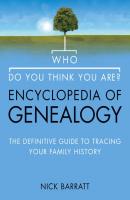Who Do You Think You Are? Encyclopedia of Genealogy: The definitive reference guide to tracing your family history. Nick Barratt
Чтение книги онлайн.

Читать онлайн книгу Who Do You Think You Are? Encyclopedia of Genealogy: The definitive reference guide to tracing your family history - Nick Barratt страница 40
Автор: Nick Barratt
Издательство: HarperCollins
Жанр: Справочная литература: прочее
isbn: 9780007372782
isbn:
2. If you find civil registration documents for your ancestors that do not give the information you were expecting to find, it may be worth looking for the parish register of whichever religious ceremony would have marked the event to see if the two records corroborate one another.
Parish Records of the Church of England
In 1538, Henry VIII’s chancellor Thomas Cromwell introduced legislation that required every priest to record all baptisms, marriages and burials within his parish, and it is these surviving records that enable genealogists to trace their ancestors beyond the start of the great record series of the nineteenth century – civil registration certificates and census returns. Few records survive this far back – on average, most English parishes have records that start around 1611 though there are some examples in Wales from 1541 – because many of the early records were not kept with any degree of care, being written on loose sheets of paper which have not survived the passage of time. A further royal proclamation was issued in 1558 instructing that these parochial events be written on parchment rather than loose paper, which increased the chances of survival; therefore 1558 is generally recognized as the start date of parish registers.
Another Act of Parliament, passed in 1597, is also important as it led to the birth of what are known as ‘Bishops’ Transcripts’. As well as compiling their own parish registers, local clergy were instructed to make annual copies of each register and send them to the bishop of the diocese in which they served. Therefore these are very useful duplicate copies of the original parish registers and can be used as an alternative if the original does not survive (or is partly or wholly illegible). However, Bishops’ Transcripts sometimes contained less detail than parish registers, or recorded slightly different information, so it is worthwhile examining both sources where possible.
There are other factors to consider when viewing the earliest registers. Other than the possibility that they may no longer be legible (ink may have faded or pages rotted), early registers were usually written in Latin. However, this shouldn’t cause too many problems. The nature of the information is fairly formulaic and is usually contained in a single sentence. Moreover, most archives have Latin dictionaries that enable you to translate words such as calendar months into English, as well as Latin versions of English names.
Another point to bear in mind is that the modern Gregorian calendar was adopted in the mid-eighteenth century instead of the old Julian calendar. Until 1752 the New Year did not begin on 1 January but 25 March. Hence, for example, all events occurring after 31 December 1675 to 24 March of the following year would belong to the year 1675, even though today we would consider them as belonging to 1676. Genealogists refer to this in their dating by using the formula ‘February 1675/6’.
Further, prior to 1813 there was no uniform method of registering events. Instead, individual clerks recorded information in their own unique ways and consequently the amount of information contained in parish registers varies considerably. Some parishes kept separate registers for baptisms, marriages and burials, whereas others prepared annual registers recording all these events together. The Rose Act was passed in 1813 and from this date all baptisms, marriages and burials were written in pre-printed books issued by the ‘King’s Printer’. These books ensured that the same details were recorded by each parish throughout the country. Often there would be more detail than had been recorded previously.
Lastly, do remember that parish registers were still kept after the introduction of civil registration in 1837 and, in theory, should exist to the present day. This is very useful when you are having problems locating events in the national GRO indexes as an equivalent record may be found in the local parish register instead, especially during the early days when civil registration was less popular or thought to be an unnecessary inconvenience.
Конец ознакомительного фрагмента.
Текст предоставлен ООО «ЛитРес».
Прочитайте эту книгу целиком, купив полную легальную версию на ЛитРес.
Безопасно оплатить книгу можно банковской картой Visa, MasterCard, Maestro, со счета мобильного телефона, с платежного терминала, в салоне МТС или Связной, через PayPal, WebMoney, Яндекс.Деньги, QIWI Кошелек, бонусными картами или другим удобным Вам способом.